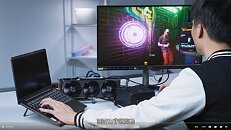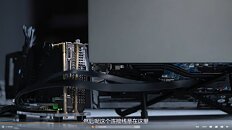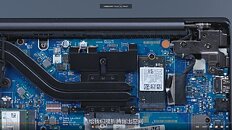Monday, January 25th 2021
Kosin Demonstrates RTX 3090 Running Via Ryzen Laptop's M.2 Slot
Kosin a Chinese subsidiary of Lenovo has recently published a video showing how they modded their Ryzen notebook to run an RTX 3090 from the NVMe M.2 slot. Kosin used their Xiaoxin Air 14 laptop with a Ryzen 5 4600U processor for the demonstration. The systems internal M.2 NVMe SSD was removed and an M.2 to PCIe expansion cable was attached allowing them to connect the RTX 3090. Finally, the laptop housing was modified to allow the PCIe cable to exit the chassis and a desktop power supply was attached to the RTX 3090 for power.
The system booted and correctly detected and utilized the attached RTX 3090. The system performed admirably scoring 14,008 points in 3DMark TimeSpy, for comparison the RTX 3090 paired with a desktop Ryzen 5 3600 scores 15,552, and when paired with a Ryzen 7 5800X scores 17,935. While this is an extreme example pairing an RTX 3090 with a mid-range mobile processor it goes to show the amount of performance achievable over the NVMe M.2 connector. The x4 PCIe 3.0 link of the laptop's M.2 slot could handle a maximum of 4 GB/s, while the x16 PCIe 3.0 slot on previous generation processors offered 16 GB/s, and the new x16 PCIe 4.0 connector doubles that providing 32 GB/s of available bandwidth.
Source:
PC Watch
The system booted and correctly detected and utilized the attached RTX 3090. The system performed admirably scoring 14,008 points in 3DMark TimeSpy, for comparison the RTX 3090 paired with a desktop Ryzen 5 3600 scores 15,552, and when paired with a Ryzen 7 5800X scores 17,935. While this is an extreme example pairing an RTX 3090 with a mid-range mobile processor it goes to show the amount of performance achievable over the NVMe M.2 connector. The x4 PCIe 3.0 link of the laptop's M.2 slot could handle a maximum of 4 GB/s, while the x16 PCIe 3.0 slot on previous generation processors offered 16 GB/s, and the new x16 PCIe 4.0 connector doubles that providing 32 GB/s of available bandwidth.




55 Comments on Kosin Demonstrates RTX 3090 Running Via Ryzen Laptop's M.2 Slot
Technically yes, they couldn't, for normal purpose other than mining.
from the early days of mxm upgrades upon the late mini-pcie slot upgrades, bandwith was the least important thing..
If the bios can not adress all the memmory or the driver just refuses to pick up the egpu the e for external-gpu turns into exit for the experiment!
With uefi and the before availible nvidia switchable graphics this is now even easier than before..
and no the amd graphics did not help as their driver where stubborn and would block /refuse to work stable.
The article should also look on the intel side where thunderbold helps egpu and you wom't need to cut open the laptop shell by any means...........
This is news from the amd laptop cpu paired to the nvidia gpu, nut not bandwith like wise.
Non encrypted uefi updates and all the options unlocked in laptop bios/uefi should be more a selling point for news than this :-P
That's just sending a native PCIe signal over a USB cable, since it has enough wires and supports the signaling rate.
Connecting this to USB will at the best case not work, and in the worst case will fry something.
The card itself is a PCIe switch with 1 upstream lane and 4 downstream lanes. I have one of those.
EDIT;
www.amazon.com/Manhattan-Adapter-Easily-Converts-151061/dp/B006VYWIVI
Then there's video capture devices that work over USB2.0.
Making an eGPU adapter for USB would be almost trivial and would work just fine.
If it were trivial, it would've been done by now, and well publicized.
www.amazon.com/ADT-Link-External-Graphics-GTX1080ti-R43SG-TU/dp/B07XZ22HQ3
You also offer no explanation as to how that would work, seeing as USB and PCIe are very, very different in how they work at a basic level (one is a DMA-capable, both-sides-can-send-data interconnect, while the other is a polling-based, non-DMA capable, master/slave connection).
Anything can be software emulated on the host side, but even considering that, that was not done. The reasons lie in latency and bandwidth issues, and that's the end of the story. This is not a viable solution for an eGPU, and no, it isn't trivial.
I believe USB-C to M.2 portable device and then using the M.2 slot to PCIE riser adapter might work in practice, but not at peak performance you'd expect of the PCIE device. If it's just the M.2 to PCIE riser though it should work near identical in practice up to the M.2's PCIE 3.0/4.0 x4 specification on the motherboard for the slot itself which is physically wired to PCIE in the first place M.2 is simply a form factor slot while the NVME device normally connected to it is a protocol.
Oh and one more thing,
What do you guys called that cable? And also...
If its not HDMI, then what type of port they used? mPCIeMI ?
www.amazon.com/EXPLOMOS-NGFF-Adapter-Power-Cable/dp/B074Z5YKXJ/ref=pd_sbs_10?pd_rd_w=mY227&pf_rd_p=c52600a3-624a-4791-b4c4-3b112e19fbbc&pf_rd_r=S91CSQJVV90GKVQS9K80&pd_rd_r=b4337651-b87f-483a-a10b-1fb81a5195b1&pd_rd_wg=lPmR8&pd_rd_i=B074Z5YKXJ&psc=1
2. 1024x768 @ 30Hz with 8-bit color is 188+ megabits of data per second. USB 1.1 hi-speed was limited to 12 mbps, so couldn't possibly display such a resolution. Even just limiting ourselves to black and white (1 bit) we're still twice over the bandwidth limit. For such an adapter USB 2.0 would be required.
3. Such an adapter would have to actively convert from the USB protocol to the PCI protocol and thusly be expensive. It would not be trivial.
4. PCI to USB? Yet you say you got a graphics output? So you mean USB to PCI, with a GPU then connected in the PCI slot?
5. Without proof of such an adapter ever existing, we're left with null and void claims. I have to side with @Yukikaze on this as I also don't think such a product would be trivial enough to produce, and the market for it would be extremely limited because of the lack of point in it. If video is all you're looking for, why the need for an eGPU in the first place? One of those USB to HDMI adapters you linked does the job just fine. If you're looking to actually take advantage of a desktop-grade GPU, USB is not the way to go for so many reasons; latency being the primary.The topic of this very article is connecting a PCIe device to a PCIe slot. Whoopdedoo. That is exactly how the protocol was intended to be used. What's 'strange' is that the PCIe slot happens to be another form factor that happens to be commonly used for storage/wifi/bt only. It's not out of the box thinking; it's using the slot for a slightly abnormal, but totally supported, use case. Converting USB to PCIe and have it function like a regular ol' PCIe slot would be in another ballpark entirely which is what @Yukikaze was trying to explain to you.Yukikaze said you couldn't run an eGPU from USB 3.0 (indicating THEY were talking about USB 3.0 being the source; as in "on the motherboard or any available USB port"), to which you replied "But akschually" and linked something that could NOT be used to connect PCIe to USB 3.0. I pointed out it is only using the cable because of the wires, not because it's USB.Number 1 is an USB to serial port adapter.
Number 2 is a proprietary cable that uses the form factor and wires of an HDMI cable but cannot be used for HDMI purposes. If you followed the link provided in the post you'd see Tongban mentioned it is used only for their eGPU solution, it is not and cannot be used for HDMI. It simply uses the wires in the cable to transfer PCIe signals, and happens to terminate in an HDMI male end.That's literally just a PCIe 3.0 x4 to PCIe 3.0 x4 "riser". Very minimal loss in signal integrity. All it does is convert form factors.USB-C is, again, just a form factor. Theoretically you could have USB 2.0 run off a type C connector. What you mean to say is Thunderbolt 3, which uses the type C connector, of which there are plenty of eGPU solutions already. Or, if you really want to do it the difficult way, you could use a USB 3.2 gen 2 (ugh, damn you, USB-IF!) to an M.2 adapter and then possibly use one of these risers to connect a GPU. However, the latency penalty of starting at USB would make the GPU useless in practice (not a problem for storage devices though, which is why NVMe drives still work semi-decently even over USB), and as you mention, streaming would be much, much, much preferred.
Still baffles me though, getting flak for using the word "utilizing" :p
You'd experience lots of latency issues perhaps depending on what was being played however, but not in all cases. You've got to take into account and consider a 1024 x 768 game today in many instances is vastly more demanding than one a decade go even at the same resolution unless settings have been well optimized at reduced settings qualities relative to the resolution. Games today have more baked in image detail on average at the same resolutions as yesterday. The big break through for USB was 2.0 full speed that enabled many more things that weren't previously possible in many area's such as eternal audio interfaces with multiple tracks of audio at reasonable latency.
ESD and Surge Protection
M.2 goes ZAP if you touch the cable after you have run over the carpet.. by-by laptop motherboardThis is just a proof of concept, it doesn't have to be consumer friendly.